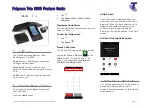
For Your Safety
202
Instrumentation (AAMI). The final draft, a joint effort by the FDA, medical device
manufacturers, and many other groups, was completed in late 2000. This standard
will allow manufacturers to ensure that cardiac pacemakers and defibrillators are
safe from wireless device EMI.
The FDA has tested hearing aids for interference from handheld wireless
devices and helped develop a voluntary standard sponsored by the Institute of
Electrical and Electronic Engineers (IEEE). This standard specifies test methods
and performance requirements for hearing aids and wireless devices so that no
interference occurs when a person uses a “compatible” device and a “compatible”
hearing aid at the same time. This standard was approved by the IEEE in 2000.
The FDA continues to monitor the use of wireless devices for possible interactions
with other medical devices. Should harmful interference be found to occur, the FDA
will conduct testing to assess the interference and work to resolve the problem.
12. Where can I find additional information?
For additional information, please refer to the following resources:
FDA web page on wireless devices
http://www.fda.gov/Radiation-EmittingProducts/
RadiationEmittingProductsandProcedures/HomeBusinessandEntertainment/
CellPhones/default.htm
Federal Communications Commission (FCC) RF Safety Program
http://www.fcc.gov/oet/rfsafety
International Commission on Non-lonizing Radiation Protection
https://www.icnirp.org
World Health Organization (WHO) International EMF Project
http://www.who.int/emf
National Radiological Protection Board (UK)
http://www.hpa.org.uk/radiation/
Summary of Contents for WING LM-F100TM
Page 6: ...Custom designed Features 01 ...
Page 28: ...Basic Functions 02 ...
Page 79: ...Useful Apps 03 ...
Page 133: ...Settings 04 ...
Page 165: ...Appendix 05 ...
Page 181: ...For Your Safety 06 ...
Page 206: ...LIMITED WARRANTY USA 07 ...
Page 213: ......











































